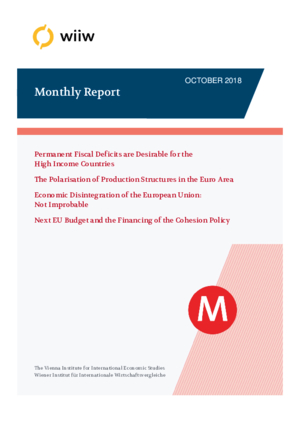Monthly Report No. 10/2018
Philipp Heimberger, Leon Podkaminer and Sandor Richter
wiiw Monthly Report No. 10, October 2018
46 pages including 1 Tables and 11 Figures
- Graph of the month: Top 5 imports into the EU from DCFTA countries, 2017
- Opinion corner: Permanent fiscal deficits are desirable for the high income countries
by Leon Podkaminer
- The polarisation of production structures in the Euro area
by Philipp Heimberger
The Euro area’s economic upswing over the course of the year 2018 has masked continued underlying polarisation of production capabilities between core and periphery countries. Ensuring long-term macroeconomic convergence and stability of the monetary union will require coordinated fiscal, wage and industrial policies.
- Economic disintegration of the European Union: not improbable
by Leon Podkaminer
In this paper it is argued that European integration has not fulfilled its chief economic promises. Output growth has been increasingly weak and unstable. Productivity growth has been following a decreasing trend. This sorry state of affairs is likely to continue – and likely to precipitate further exits, or eventually, the dissolution of the Union. However, this outcome is not unavoidable. Moreover, the negative consequences implicit in the current architecture of the common currency could be neutralised. However, the basic paradigms of the economic policies to be followed in the EU would have to be radically changed. First, the unconditional fiscal consolidation provisions still in force would have to be repelled. Second, ‘beggar-thy-neighbour’ (or mercantilist) wage policies would have to be ‘outlawed’.
- Next EU budget and the financing of the Cohesion policy
by Sándor Richter
In the EU’s next Multiannual Financial Framework the share of Cohesion policy funds will likely be smaller than in the current one, leading to serious conflicts between net contributor and net beneficiary member states. The solution to avoid these conflicts may be the integration of a market based support of investment following the pattern of the “Juncker Plan” into the future cohesion policy.
- Statistical Annex: Monthly and quarterly statistics for Central, East and Southeast Europe
Reference to wiiw databases: wiiw Annual Database, wiiw Monthly Database
Keywords: foreign trade, DCFTA, fiscal, deficit, fiscal policy, polarisation of production structures, core and periphery countries, macroeconomic convergence, Euro area, disintegration, EU, EU budget, Cohesion policy, EFSI, Juncker Plan
Countries covered: European Union, Georgia, Moldova, OECD, Ukraine
Research Areas: Macroeconomic Analysis and Policy, International Trade, Competitiveness and FDI, Sectoral studies
